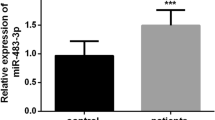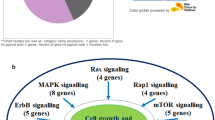Abstract
Objective
This study is to identify the effects of miRNA-140-5p on necrotizing pneumonia (NP) and its underlying mechanism.
Methods
The mRNA levels of miRNA-140-5p and TLR4 and secretion of IL-1β, IL-6, and TNF-α in peripheral blood from children with NP and healthy volunteers were determined using qRT-PCR and specific ELISAs. The interactions between miRNA-140-5p and TLR4 were investigated using a dual-luciferase reporter system. Cell viabilities were determined using a CCK-8 assay. qRT-PCR, western blotting, and specific ELISAs were applied to determine the expressions of genes in the cells. Peripheral blood from children with NP had significantly elevated levels of TLR4 but significantly lower levels of miR-140-5p compared to the control.
Results
Spearman’s rank correlation analysis showed a negative correlation between TLR4 and miR-140-5p. miR-140-5p regulated the expressions of TLR4 in A549 cells. Additionally, LPS induced a significant enhancement in the levels of TLR4 but significant reduction in the levels of miR-140-5p. The overexpression of miR-140-5p suppressed cell apoptosis and induced the release of inflammatory cytokines in the LPS-induced A549 cells.
Conclusion
The underlying mechanisms of miR-140-5p on the regulation of TLR4 are in part by the regulation of p65. The miR-140-5p inhibits necrotizing pneumonia by regulating TLR-4 via TNF–p65 signaling pathway.






Similar content being viewed by others
References
Beutler, B. Tlr4: central component of the sole mammalian LPS sensor. Curr. Opin. Immunol. 12(1):20–26, 2000.
Chuang, C. Y., T. L. Chen, Y. G. Cherng, Y. T. Tai, T. G. Chen, and R. M. Chen. Lipopolysaccharide induces apoptotic insults to human alveolar epithelial A549 cells through reactive oxygen species-mediated activation of an intrinsic mitochondrion-dependent pathway. Arch. Toxicol. 85(3):209–218, 2011.
Demedts, I. K., K. R. Bracke, T. Maes, G. F. Joos, and G. G. Brusselle. Different roles for human lung dendritic cell subsets in pulmonary immune defense mechanisms. Am. J. Respir. Cell Mol. Biol. 35(3):387–393, 2006.
Fei, S., L. Cao, and L. Pan. microRNA-3941 targets IGF2 to control LPS-induced acute pneumonia in A549 cells. Mol. Med. Rep. 17(3):4019–4026, 2018.
Guo, J., and Y. Cheng. MicroRNA-1247 inhibits lipopolysaccharides-induced acute pneumonia in A549 cells via targeting CC chemokine ligand 16. Biomed. Pharmacother. 104:60–68, 2018.
Guo, H., R. Q. Qi, J. Sheng, C. Liu, H. Ma, H. X. Wang, J. H. Li, X. H. Gao, Y. S. Wan, and H. D. Chen. MiR-155, a potential serum marker of extramammary Paget’s disease. BMC Cancer 18(1):1078, 2018.
Hacimustafaoglu, M., S. Celebi, H. Sarimehmet, A. Gurpinar, and I. Ercan. Necrotizing pneumonia in children. Acta Paediatr. 93(9):1172–1177, 2004.
Jiang, K., T. Zhang, N. Yin, X. Ma, G. Zhao, H. Wu, C. Qiu, and G. Deng. Geraniol alleviates LPS-induced acute lung injury in mice via inhibiting inflammation and apoptosis. Oncotarget 8(41):71038, 2017.
Kaisho, T., and S. Akira. Toll-like receptors and their signaling mechanism in innate immunity. Acta Odontol. Scand. 59(3):124–130, 2001.
Kawai, T., and S. Akira. Toll-like receptors and their crosstalk with other innate receptors in infection and immunity. Immunity 34(5):637–650, 2011.
Kayagaki, N., M. T. Wong, I. B. Stowe, S. R. Ramani, L. C. Gonzalez, S. Akashi-Takamura, K. Miyake, J. Zhang, W. P. Lee, A. Muszynski, L. S. Forsberg, R. W. Carlson, and V. M. Dixit. Noncanonical inflammasome activation by intracellular LPS independent of TLR4. Science 341(6151):1246–1249, 2013.
Kerem, E., Y. Bar Ziv, B. Rudenski, S. Katz, D. Kleid, and D. Branski. Bacteremic necrotizing pneumococcal pneumonia in children. Am. J. Respir. Crit. Care Med. 149(1):242–244, 1994.
Krenke, K., M. Sanocki, E. Urbankowska, G. Kraj, M. Krawiec, T. Urbankowski, J. Peradzynska, and M. Kulus. Necrotizing pneumonia and its complications in children. Adv. Exp. Med. Biol. 857:9–17, 2015.
Kumar, H., T. Kawai, and S. Akira. Toll-like receptors and innate immunity. Biochem. Biophys. Res. Commun. 388(4):621–625, 2009.
Labandeira-Rey, M., F. Couzon, S. Boisset, E. L. Brown, M. Bes, Y. Benito, E. M. Barbu, V. Vazquez, M. Höök, and J. Etienne. Staphylococcus aureus Panton-Valentine leukocidin causes necrotizing pneumonia. Science 315(5815):1130–1133, 2007.
Li, X., J. Wang, H. Wu, P. Guo, C. Wang, Y. Wang, and Z. Zhang. Reduced peripheral blood miR-140 may be a biomarker for acute lung injury by targeting Toll-like receptor 4 (TLR4). Exp. Ther. Med. 16(4):3632–3638, 2018.
Liu, M., T. Han, S. Shi, and E. Chen. Long noncoding RNA HAGLROS regulates cell apoptosis and autophagy in lipopolysaccharides-induced WI-38cells via modulating miR-100/NF-kappaB axis. Biochem. Biophys. Res. Commun. 500(3):589–596, 2018.
Liu, Y., H. Yin, M. Zhao, and Q. Lu. TLR2 and TLR4 in autoimmune diseases: a comprehensive review. Clin. Rev. Allergy Immunol. 47(2):136–147, 2014.
Lu, Y. C., W. C. Yeh, and P. S. Ohashi. LPS/TLR4 signal transduction pathway. Cytokine 42(2):145–151, 2008.
Masters, I. B., A. F. Isles, and K. Grimwood. Necrotizing pneumonia: an emerging problem in children? Pneumonia 9:11, 2017.
McAlinden, A., and G. I. Im. MicroRNAs in orthopaedic research: disease associations, potential therapeutic applications, and perspectives. J. Orthop. Res. 36(1):33–51, 2018.
Miller, S. I., R. K. Ernst, and M. W. Bader. LPS, TLR4 and infectious disease diversity. Nat. Rev. Microbiol. 3(1):36–46, 2005.
Rouzic, N., F. Janvier, N. Libert, E. Javouhey, G. Lina, J. Y. Nizou, P. Pasquier, D. Stamm, L. Brinquin, C. Pelletier, F. Vandenesch, D. Floret, J. Etienne, and Y. Gillet. Prompt and successful toxin-targeting treatment of three patients with necrotizing pneumonia due to Staphylococcus aureus strains carrying the Panton-Valentine leukocidin genes. J. Clin. Microbiol. 48(5):1952–1955, 2010.
Soifer, H. S., J. J. Rossi, and P. Saetrom. MicroRNAs in disease and potential therapeutic applications. Mol. Ther. 15(12):2070–2079, 2007.
Standiford, L. R., T. J. Standiford, M. J. Newstead, X. Zeng, M. N. Ballinger, M. A. Kovach, A. K. Reka, and U. Bhan. TLR4-dependent GM-CSF protects against lung injury in Gram-negative bacterial pneumonia. Am. J. Physiol. Lung Cell Mol. Physiol. 302(5):L447–L454, 2012.
Sun, W., C. Liu, Y. Zhang, X. Qiu, L. Zhang, H. Zhao, Y. Rong, Y. Sun, and A. Ilexgenin. a novel pentacyclic triterpenoid extracted from Aquifoliaceae shows reduction of LPS-induced peritonitis in mice. Eur. J. Pharmacol. 797:94–105, 2017.
Wu, Q., H. Li, J. Qiu, and H. Feng. Betulin protects mice from bacterial pneumonia and acute lung injury. Microb. Pathog. 75:21–28, 2014.
Yang, H., J. Wang, J. H. Fan, Y. Q. Zhang, J. X. Zhao, X. J. Dai, Q. Liu, Y. J. Shen, C. Liu, W. D. Sun, and Y. Sun. Ilexgenin A exerts anti-inflammation and anti-angiogenesis effects through inhibition of STAT3 and PI3K pathways and exhibits synergistic effects with Sorafenib on hepatoma growth. Toxicol. Appl. Pharmacol. 315:90–101, 2017.
Zhang, Q., Y. Weng, Y. Jiang, S. Zhao, D. Zhou, and N. Xu. Overexpression of miR-140-5p inhibits lipopolysaccharide-induced human intervertebral disc inflammation and degeneration by downregulating toll-like receptor 4. Oncol. Rep. 40(2):793–802, 2018.
Zhou, W., X. Wang, D. Yin, L. Xue, Z. Ma, Z. Wang, Q. Zhang, Z. Zhao, H. Wang, Y. Sun, and Y. Yang. Effect of miR-140-5p on the regulation of proliferation and apoptosis in NSCLC and its underlying mechanism. Exp. Ther. Med. 18(2):1350–1356, 2019.
Funding
The study was supported by the General Support Project for Outstanding Youth in Universities in Anhui Province (gxyq2017091); R & D Projects Entrusted by Enterprises (2020XHX026); Priority Projects on Natural Science of Suzhou University (2016yzd04).
Author information
Authors and Affiliations
Corresponding author
Ethics declarations
Conflict of interest
The authors declare that they have no conflict of interest.
Additional information
Associate Editor Ankur Singh oversaw the review of this article.
Publisher's Note
Springer Nature remains neutral with regard to jurisdictional claims in published maps and institutional affiliations.
Supplementary Information
Below is the link to the electronic supplementary material.
Rights and permissions
About this article
Cite this article
Wang, H., Wu, C. & Kong, D. miR-140-5p Overexpression Protects Against Lipopolysaccharide-Induced Necrotizing Pneumonia via Targeting Toll-Like Receptor 4. Cel. Mol. Bioeng. 14, 339–348 (2021). https://doi.org/10.1007/s12195-021-00673-0
Received:
Accepted:
Published:
Issue Date:
DOI: https://doi.org/10.1007/s12195-021-00673-0




